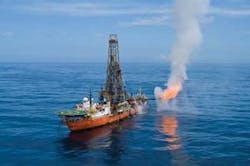Promising Galoc to support next wave of Philippine exploration
Gurdip Singh - Contributing Editor
Australia’s Nido Petroleum Ltd. is staying focused on the Palawan Sea, where its first field, Galoc, commenced production on Oct. 9 after a challenging development phase.
The Galoc development by Nido and partners has gone through two storms this year but is now certain to bear fruit with light crude, which will boost the oil-import dependent Philippines’ energy economy.
Production is expected to reach about 20,000 b/d from the two wells with an average of about 17,000 b/d over the remainder of 2008.
Galoc is expected to increase the Philippines’ indigenous oil production to over 40,000 b/d from 23,000 b/d. The country imports 94% of its 338,000 b/d oil consumption from the Middle East.
Galoc is fully endorsed by the Philippine government. President Gloria Macapagal-Arroyo has stressed the importance of indigenous energy supply among her many views and comments on domestic energy issues.
“We need a reform package industry-wide of energy savings and independence because we have always been dependent on imported energy and therefore, vulnerable to the vagaries of global politics and economics, particularly events bearing on oil supply such as war, terrorism, and currency fluctuations,” Arroyo has said.
Galoc will be the next biggest energy industry celebration after the Malampaya Deepwater Gas Project, the main source of natural gas for power and industrial sector in the country since October 2001.
The government’s overall objective is to reduce energy import and aims for 60% self-sufficiency level by 2010.
Work on the project was delayed by Tropical Storm Cosme in May and Typhoon Fengshen in June this year.
The FPSORubcion Intrepid was mobilized to the field for the beginning of hook-up and commissioning operations in May. But the passage of Tropical Storm Cosme necessitated the postponement of this work for almost 10 days, says Nido.
When field operations began, substantial progress was made toward first oil, with the FPSO being moored and hooked up to the mooring and riser system, and pre-production work within two days of oil flow to the vessel.
However, June brought Typhoon Fengshen and the FPSO was forced to execute a controlled disconnection and seek shelter from the storm.
But when the FPSO returned to the field, an inspection of the mooring and riser system showed that the riser had been “kinked” during the disconnection process and would require replacement. Work on the replacement of the damaged riser section was completed and a full system safety and integrity check was undertaken.
Tropical storms have continued to plague the project. Typhoon Hagupit traveled to the north of Galoc in late September and again affected the progress of the field development.
But a new support vessel,CSO Venturer, arrived in the field to help minimize the potential for further delays in the remaining work program, and soon after first oil was announced from the field.
Other exploration
Galoc cash flow will underwrite the exploration program of the Northwest Palawan basin, says Nido. The Perth-based company has a 50/50 partnership with the Philippine National Oil Co. (PNOC) in SC58 and SC63, and a 60/40 partnership with Kariki Energy Ltd. in SC54.
Nido has 22.5-28.2% working interest in SC14 with Matinloc and 22.3% working interest in Galoc field, which was discovered in 1981. The field is operated by Galoc Production Co. The other partners are European trader Vitol, Otto Energy, and a number of Philippine companies.
Meanwhile, Nido and Kairiki have signed the jackup drilling rigWilBoss for continuing exploration in SC54.
Wilboss, a 2008-built rig of Norway’s Awilco Offshore ASA, is set to begin a drilling campaign with the Yakal-1 well, followed by Tindalo-1.
Nido says it secured theWilBoss in a tight rig market earlier this year through an assignment agreement.
The company has identified more than 100 leads with some five undeveloped oil and gas discoveries in the 3 million hectares of prime exploration acreage in the Palawan basin.
Nido claims to have the basin’s most comprehensive data, which has been accumulated since 1995.
It says 70 exploration wells have been drilled in the basin with just one giant discovery - the Malampaya field - with 535 MMboe. Of those 70 wells drilled, 45% were oil and gas discoveries and 31% oil and gas shows, while only 24% were dry wells.
Last year, its seismic campaign focused on SC54, SC58, and SC63, acquiring 5,500 km (3,428 mi) of regional 2D and 825 km (513 mi) of prospect 3D.
The Philippines import 31.9% of its oil from Saudi Arabia, 25.9% from Iran, 19.6% from the United Arab Emirates, 9.4% from Oman, 6.7% from Qatar, 2.1% from Australia, 1.3% from Indonesia, and 0.8% from Yemen.
But to encourage more indigenous oil and gas exploration, the government offers attractive hydrocarbon exploitation terms. Contractors are allowed to recover costs up to 70% of gross revenue while the remaining revenue is split 60/40 in favor of the government. But it then allows income tax payment from the government share.

